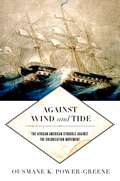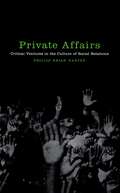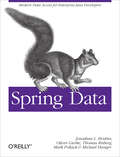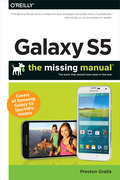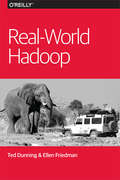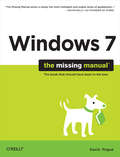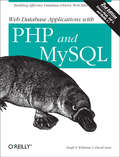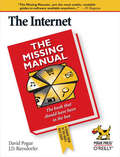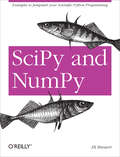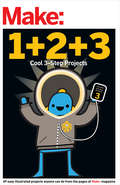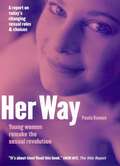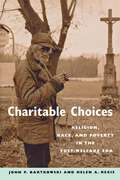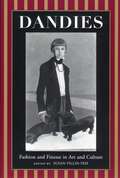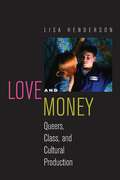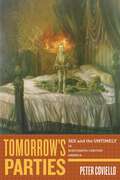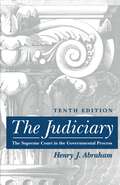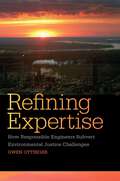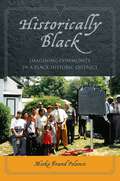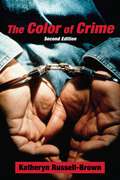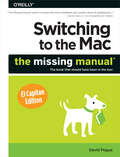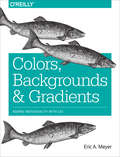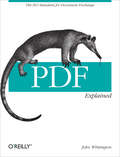- Table View
- List View
Against Wind and Tide: The African American Struggle against the Colonization Movement (Early American Places #10)
by Ousmane K. Power-GreeneAgainst Wind and Tide tells the story of African American’s battle against the American Colonization Society (ACS), founded in 1816 with the intention to return free blacks to its colony Liberia. Although ACS members considered free black colonization in Africa a benevolent enterprise, most black leaders rejected the ACS, fearing that the organization sought forced removal. As Ousmane K. Power-Greene’s story shows, these African American anticolonizationists did not believe Liberia would ever be a true “black American homeland.”In this study of anticolonization agitation, Power-Greene draws on newspapers, meeting minutes, and letters to explore the concerted effort on the part of nineteenth century black activists, community leaders, and spokespersons to challenge the American Colonization Society’s attempt to make colonization of free blacks federal policy. The ACS insisted the plan embodied empowerment. The United States, they argued, would never accept free blacks as citizens, and the only solution to the status of free blacks was to create an autonomous nation that would fundamentally reject racism at its core. But the activists and reformers on the opposite side believed that the colonization movement was itself deeply racist and in fact one of the greatest obstacles for African Americans to gain citizenship in the United States.Power-Greene synthesizes debates about colonization and emigration, situating this complex and enduring issue into an ever broader conversation about nation building and identity formation in the Atlantic world.
Private Affairs: Critical Ventures in the Culture of Social Relations (Sexual Cultures #22)
by Phillip Brian HarperIn Private Affairs, Phillip Brian Harper explores the social and cultural significance of the private, proposing that, far from a universal right, privacy is limited by one's racial-and sexual-minority status. Ranging across cinema, literature, sculpture, and lived encounters-from Rodin's The Kiss to Jenny Livingston's Paris is Burning-Private Affairs demonstrates how the very concept of privacy creates personal and sociopolitical hierarchies in contemporary America.
Spring Data: Modern Data Access for Enterprise Java
by Mark Pollack Oliver Gierke Thomas Risberg Jon Brisbin Michael HungerYou can choose several data access frameworks when building Java enterprise applications that work with relational databases. But what about big data? This hands-on introduction shows you how Spring Data makes it relatively easy to build applications across a wide range of new data access technologies such as NoSQL and Hadoop.Through several sample projects, you’ll learn how Spring Data provides a consistent programming model that retains NoSQL-specific features and capabilities, and helps you develop Hadoop applications across a wide range of use-cases such as data analysis, event stream processing, and workflow. You’ll also discover the features Spring Data adds to Spring’s existing JPA and JDBC support for writing RDBMS-based data access layers.Learn about Spring’s template helper classes to simplify the use ofdatabase-specific functionalityExplore Spring Data’s repository abstraction and advanced query functionalityUse Spring Data with Redis (key/value store), HBase(column-family), MongoDB (document database), and Neo4j (graph database)Discover the GemFire distributed data grid solutionExport Spring Data JPA-managed entities to the Web as RESTful web servicesSimplify the development of HBase applications, using a lightweight object-mapping frameworkBuild example big-data pipelines with Spring Batch and Spring Integration
Galaxy S5: The Missing Manual
by Preston GrallaGet the most out of Samsung’s Galaxy S5 smartphone right from the start. With clear instructions from technology expert Preston Gralla, this Missing Manual gives you a guided tour of Samsung's new flagship phone, including great new features such as the fingerprint scanner, heart rate sensor, and Download Booster. You’ll get expert tips and tricks for playing music, calling and texting, shooting photos and videos, and even getting some work done.The important stuff you need to know:Get connected. Browse the Web, manage email, and download apps from Google Play through WiFi or 3G/4G network.Keep in touch. Call, text, chat, videochat, conduct conference calls, and reach out with Facebook and Twitter.Capture and display images. Shoot, edit, show, and share photos, slideshows, and high-definition videos.Play and manage your music. Buy music from Google Play or Amazon and listen to it with Galaxy S5’s Music app.Work anywhere. Access your files, company network, calendar, and contacts—and work with Google Docs.Connect to Google Maps. Use geolocation and turn-by-turn drive directions to find your way.Stay fit with S Health. Use this built-in app to keep track of fitness goals, walking, heart rate, blood pressure, and more.
Real-World Hadoop
by Ellen Friedman Ted DunningIf you’re a business team leader, CIO, business analyst, or developer interested in how Apache Hadoop and Apache HBase-related technologies can address problems involving large-scale data in cost-effective ways, this book is for you. Using real-world stories and situations, authors Ted Dunning and Ellen Friedman show Hadoop newcomers and seasoned users alike how NoSQL databases and Hadoop can solve a variety of business and research issues.You’ll learn about early decisions and pre-planning that can make the process easier and more productive. If you’re already using these technologies, you’ll discover ways to gain the full range of benefits possible with Hadoop. While you don’t need a deep technical background to get started, this book does provide expert guidance to help managers, architects, and practitioners succeed with their Hadoop projects.Examine a day in the life of big data: India’s ambitious Aadhaar projectReview tools in the Hadoop ecosystem such as Apache’s Spark, Storm, and Drill to learn how they can help youPick up a collection of technical and strategic tips that have helped others succeed with HadoopLearn from several prototypical Hadoop use cases, based on how organizations have actually applied the technologyExplore real-world stories that reveal how MapR customers combine use cases when putting Hadoop and NoSQL to work, including in production
Squid: The Definitive Guide
by Duane WesselsSquid is the most popular Web caching software in use today, and it works on a variety of platforms including Linux, FreeBSD, and Windows. Squid improves network performance by reducing the amount of bandwidth used when surfing the Web. It makes web pages load faster and can even reduce the load on your web server. By caching and reusing popular web content, Squid allows you to get by with smaller network connections. It also protects the host on your internal network by acting as a firewall and proxying your internal web traffic. You can use Squid to collect statistics about the traffic on your network, prevent users from visiting inappropriate web sites at work or school, ensure that only authorized users can surf the Internet, and enhance your privacy by filtering sensitive information from web requests. Companies, schools, libraries, and organizations that use web-caching proxies can look forward to a multitude of benefits.Written by Duane Wessels, the creator of Squid, Squid: The Definitive Guide will help you configure and tune Squid for your particular situation. Newcomers to Squid will learn how to download, compile, and install code. Seasoned users of Squid will be interested in the later chapters, which tackle advanced topics such as high-performance storage options, rewriting requests, HTTP server acceleration, monitoring, debugging, and troubleshooting Squid.Topics covered include:Compiling and installing SquidRunning SquidUsing Squid's sophisticated access controlsTuning disk storage for optimal performanceConfiguring your operating system for HTTP interceptionForwarding Requests to other web cachesUsing redirectors to rewrite user requestsMonitoring Squid with the cache manager and SNMPUsing Squid to accelerate and protect HTTP serversManaging bandwidth consumption with Delay Pools
Windows 7: The Missing Manual (The\missing Manual Ser.)
by David PogueIn early reviews, geeks raved about Windows 7. But if you're an ordinary mortal, learning what this new system is all about will be challenging. Fear not: David Pogue's Windows 7: The Missing Manual comes to the rescue. Like its predecessors, this book illuminates its subject with reader-friendly insight, plenty of wit, and hardnosed objectivity for beginners as well as veteran PC users. Windows 7 fixes many of Vista's most painful shortcomings. It's speedier, has fewer intrusive and nagging screens, and is more compatible with peripherals. Plus, Windows 7 introduces a slew of new features, including better organization tools, easier WiFi connections and home networking setup, and even touchscreen computing for those lucky enough to own the latest hardware. With this book, you'll learn how to:Navigate the desktop, including the fast and powerful search functionTake advantage of Window's apps and gadgets, and tap into 40 free programsBreeze the Web with Internet Explorer 8, and learn the email, chat, and videoconferencing programsRecord TV and radio, display photos, play music, and record any of these to DVD using the Media CenterUse your printer, fax, laptop, tablet PC, or smartphone with Windows 7Beef up your system and back up your filesCollaborate and share documents and other files by setting up a workgroup network
Web Database Applications with PHP and MySQL: Building Effective Database-Driven Web Sites
by David Lane Hugh E. WilliamsThere are many reasons for serving up dynamic content from a web site: to offer an online shopping site, create customized information pages for users, or just manage a large volume of content through a database. Anyone with a modest knowledge of HTML and web site management can learn to create dynamic content through the PHP programming language and the MySQL database. This book gives you the background and tools to do the job safely and reliably.Web Database Applications with PHP and MySQL, Second Edition thoroughly reflects the needs of real-world applications. It goes into detail on such practical issues as validating input (do you know what a proper credit card number looks like?), logging in users, and using templatesto give your dynamic web pages a standard look.But this book goes even further. It shows how JavaScript and PHP can be used in tandem to make a user's experience faster and more pleasant. It shows the correct way to handle errors in user input so that a site looks professional. It introduces the vast collection of powerful tools available in the PEAR repository and shows how to use some of the most popular tools.Even while it serves as an introduction to new programmers, the book does not omit critical tasks that web sites require. For instance, every site that allows updates must handle the possibility of multiple users accessing data at the same time. This book explains how to solve the problem in detail with locking.Through a sophisticated sample application--Hugh and Dave's Wine Store--all the important techniques of dynamic content are introduced. Good design is emphasized, such as dividing logic from presentation. The book introduces PHP 5 and MySQL 4.1 features, while providing techniques that can be used on older versions of the software that are still in widespread use.This new edition has been redesigned around the rich offerings of PEAR. Several of these, including the Template package and the database-independent query API, are fully integrated into examples and thoroughly described in the text. Topics include:Installation and configuration of Apache, MySQL, and PHP on Unix®, Windows®, and Mac OS® X systemsIntroductions to PHP, SQL, and MySQL administrationSession management, including the use of a custom database for improved efficiencyUser input validation, security, and authenticationThe PEAR repository, plus details on the use of PEAR DB and Template classesProduction of PDF reports
The Internet: The Missing Manual (Missing Manual)
by David Pogue J. D. BiersdorferThe Internet is almost synonymous with change--that's one of its charms, and one of its headaches. You may think you know the Internet, but are you really up to speed on internet telephones, movie and TV downloading, blogging, gaming, online banking, dating, and photosharing? This utterly current book covers:Getting Online. Readers will have all the information they need to decide what kind of broadband connection works best for them, which browser they should use, and what kind of spyware-fighting and virus-and spam-protection measures they need to protect themselves.Finding Information. Google may be the leading search site, but it's certainly not the only game in town. This book introduces a diverse and useful collection of sites that help uncover everything from health care information, to shopping, travel and finance, to dependable reviews and ratings.Movies, music, and photos. The Web's teeming with entertainment--and not just the sort of postage-stamp sized videos that only a geek could love. Learn where to download movies, watch TV online, listen to music, play games, and post and share photos with friends.Keeping in touch. Email's only the beginning. This book introduces readers to the many tools that make the modern Internet such a great way to stay connected. From Web-based discussion groups to instant messaging programs, and from blogs and podcasts to Internet-based phone calls, this book will help you join the conversation.Ideal for anyone just venturing into cyberspace, this book is also perfect for more experienced users who could use an update to today's most exciting internet applications.
SciPy and NumPy: An Overview for Developers (Oreilly And Associate Ser.)
by Eli BressertAre you new to SciPy and NumPy? Do you want to learn it quickly and easily through examples and a concise introduction? Then this is the book for you. You’ll cut through the complexity of online documentation and discover how easily you can get up to speed with these Python libraries.Ideal for data analysts and scientists in any field, this overview shows you how to use NumPy for numerical processing, including array indexing, math operations, and loading and saving data. You’ll learn how SciPy helps you work with advanced mathematical functions such as optimization, interpolation, integration, clustering, statistics, and other tools that take scientific programming to a whole new level.The new edition is now available, fully revised and updated in June 2013.Learn the capabilities of NumPy arrays, element-by-element operations, and core mathematical operationsSolve minimization problems quickly with SciPy’s optimization packageUse SciPy functions for interpolation, from simple univariate to complex multivariate casesApply a variety of SciPy statistical tools such as distributions and functionsLearn SciPy’s spatial and cluster analysis classesSave operation time and memory usage with sparse matrices
Effective Modern C++: 42 Specific Ways to Improve Your Use of C++11 and C++14
by Scott MeyersComing to grips with C++11 and C++14 is more than a matter of familiarizing yourself with the features they introduce (e.g., auto type declarations, move semantics, lambda expressions, and concurrency support). The challenge is learning to use those features effectively—so that your software is correct, efficient, maintainable, and portable. That’s where this practical book comes in. It describes how to write truly great software using C++11 and C++14—i.e. using modern C++.Topics include:The pros and cons of braced initialization, noexcept specifications, perfect forwarding, and smart pointer make functionsThe relationships among std::move, std::forward, rvalue references, and universal referencesTechniques for writing clear, correct, effective lambda expressionsHow std::atomic differs from volatile, how each should be used, and how they relate to C++'s concurrency APIHow best practices in "old" C++ programming (i.e., C++98) require revision for software development in modern C++Effective Modern C++ follows the proven guideline-based, example-driven format of Scott Meyers' earlier books, but covers entirely new material."After I learned the C++ basics, I then learned how to use C++ in production code from Meyer's series of Effective C++ books. Effective Modern C++ is the most important how-to book for advice on key guidelines, styles, and idioms to use modern C++ effectively and well. Don't own it yet? Buy this one. Now".-- Herb Sutter, Chair of ISO C++ Standards Committee and C++ Software Architect at Microsoft
Make: From the Pages of Make:
by The Editors of Make:From the pages of Make: magazine comes this collection of dozens of projects you can make in your home or school workshop. You'll learn how to create toys and games from stuff you have lying around, create unusual and inspiring home improvements, and even find some new ways to have fun outdoors. You might even learn something along the way: electronics, flight, science, math, and engineering. In this book, you'll make:Batteries from everyday thingsBanana tattoosLED throwiesPiezo contact microphonePaper water bomberBox fan beef jerky
Her Way: Young Women Remake the Sexual Revolution
by Paula KamenHow young woman are redefining sex 30 years after the Sexual RevolutionThree decades after the Sexual Revolution, women's power and status have begun to match men's, and women are finally making the rules in order to experience a more radical and truer form of liberation. Her Way demonstrates how and why 20- and 30-something women have evolved to act and think more like men sexually, while also creating their own distinct sexual patterns and appetites. Today's young women are now the leaders of an unreported but sweeping "Sexual Evolution," in which women take control of sex and redefine it from their perspective. In other words, do it "her way." Paula Kamen characterizes this Sexual Evolution according to two major developments that are setting sexual patterns for future generations of women: young women's sexual profiles are now remarkably similar to those of men, in terms of age of first intercourse, and numbers of sex partners and casual encounters. They also feel less guilt or shame about their behavior, from premarital sex to having a child out of marriage to coming out of the closet to cohabiting. Yet young women are not merely imitating men, but forging their own distinct sexual perspectives and asserting their own needs. In addition to discovering the pleasures of sex, young women are also exploring the dilemmas, challenging male-defined sexual scripts, and changing what actually goes on in bed. Based on more than one hundred lively, unfiltered and in-depth interviews with women across the country, Her Way cuts through the sensationalism and speculation of popular discussions about young women and sex. Kamen reports the real story of today's enhanced sexual expectations and choices.
Charitable Choices: Religion, Race, and Poverty in the Post-Welfare Era
by John P. Bartkowski Helen A. RegisCongregations and faith-based organizations have become key participants in America’s welfare revolution. Recent legislation has expanded the social welfare role of religious communities, thus revealing a pervasive lack of faith in purely economic responses to poverty.Charitable Choices is an ethnographic study of faith-based poverty relief in 30 congregations in the rural south. Drawing on in-depth interviews and fieldwork in Mississippi faith communities, it examines how religious conviction and racial dynamics shape congregational benevolence. Mississippi has long had the nation's highest poverty rate and was the first state to implement a faith-based welfare reform initiative. The book provides a grounded and even-handed treatment of congregational poverty relief rather than abstract theory on faith-based initiatives. The volume examines how congregations are coping with national developments in social welfare policy and reveals the strategies that religious communities utilize to fight poverty in their local communities. By giving particular attention to the influence of theological convictions and organizational dynamics on religious service provision, it identifies both the prospects and pitfalls likely to result from the expansion of charitable choice.
Dandies: Fashion and Finesse in Art and Culture
by Susan Fillin-YehDandies: Fashion and Finesse in Art and Culture considers the visual languages, politics, and poetics of personal appearance. Dandyism has been most closely associated with influential caucasian Western men-about-town, epitomized by the 19th century style-setting of Oscar Wilde and by Tom Wolfe's white suits. The essays collected here, however, examine the spectacle and workings of dandyism to reveal that these were not the only dandies. On the contrary, art historians, literary and cultural historians, and anthropologists identify unrecognized dandies flourishing among early 19th century Native Americans, in Soviet Latvia, in Africa, throughout the African-American diaspora, among women, and in the art world. Moving beyond historical and fictional accounts of dandies, this volume juxtaposes theoretical models with evocative images and descriptions of clothing in order to link sartorial self-construction with artistic, social, and political self-invention. Taking into consideration the vast changes in thinking about identity in the academy, Dandies provides a compelling study of dandyism's destabilizing aesthetic enterprise. Contributors: Jennifer Blessing, Susan Fillin-Yeh, Rhonda Garelick, Joe Lucchesi, Kim Miller, Robert E. Moore, Richard J. Powell, Carter Ratcliffe, and Mark Allen Svede.
Love and Money: Queers, Class, and Cultural Production (Critical Cultural Communication #18)
by Lisa HendersonLove and Money argues that we can’t understand contemporary queer cultures without looking through the lens of social class. Resisting old divisions between culture and economy, identity and privilege, left and queer, recognition and redistribution, Love and Money offers supple approaches to capturing class experience and class form in and around queerness.Contrary to familiar dismissals, not every queer television or movie character is like Will Truman on Will and Grace—rich, white, healthy, professional, detached from politics, community, and sex. Through ethnographic encounters with readers and cultural producers and such texts as Boys Don’t Cry, Brokeback Mountain, By Hook or By Crook, and wedding announcements in the New York Times, Love and Money sees both queerness and class across a range of idioms and practices in everyday life. How, it asks, do readers of Dorothy Allison’s novels use her work to find a queer class voice? How do gender and race broker queer class fantasy? How do independent filmmakers cross back and forth between industry and queer sectors, changing both places as they go and challenging queer ideas about bad commerce and bad taste?With an eye to the nuances and harms of class difference in queerness and a wish to use culture to forge queer and class affinities, Love and Money returns class and its politics to the study of queer life.
Italian American: The Racializing of an Ethnic Identity
by David A.J. RichardsWhen southern Italians began emigrating to the U.S. in large numbers in the 1870s-part of the "new immigration" from southern and eastern rather than northern Europe-they were seen as racially inferior, what David A. J. Richards terms "nonvisibly" black. The first study of its kind, Italian American explores the acculturation process of Italian immigrants in terms of then-current patterns of European and American racism. Delving into the political and legal context of flawed liberal nationalism both in Italy (the Risorgimento) and the United States (Reconstruction Amendments), Richards examines why Italian Americans were so reluctant to influence depictions of themselves and their own collective identity. He argues that American racism could not have had the durability or political power it has had either in the popular understanding or in the corruption of constitutional ideals unless many new immigrants, themselves often regarded as racially inferior, had been drawn into accepting and supporting many of the terms of American racism. With its unprecedented focus on Italian American identity and an interdisciplinary approach to comparative culture and law, this timely study sheds important light on the history and contemporary importance of identity and multicultural politics in American political and constitutional debate.
Tomorrow's Parties: Sex and the Untimely in Nineteenth-Century America (America and the Long 19th Century #1)
by Peter CovielloHonorable Mention for the 2014 MLA Alan Bray Memorial Award Finalist for the 2013 LAMBDA LGBT Studies Book AwardIn nineteenth-century America—before the scandalous trial of Oscar Wilde, before the public emergence of categories like homo- and heterosexuality—what were the parameters of sex? Did people characterize their sexuality as a set of bodily practices, a form of identification, or a mode of relation? Was it even something an individual could be said to possess? What could be counted as sexuality?Tomorrow’s Parties: Sex and the Untimely in Nineteenth-Century America provides a rich new conceptual language to describe the movements of sex in the period before it solidified into the sexuality we know, or think we know. Taking up authors whose places in the American history of sexuality range from the canonical to the improbable—from Whitman, Melville, Thoreau, and James to Dickinson, Sarah Orne Jewett, Harriet Jacobs, Frederick Douglass, and Mormon founder Joseph Smith—Peter Coviello delineates the varied forms sex could take in the lead-up to its captivation by the codings of “modern” sexuality. While telling the story of nineteenth-century American sexuality, he considers what might have been lostin the ascension of these new taxonomies of sex: all the extravagant, untimely ways of imagining the domain of sex that, under the modern regime of sexuality, have sunken into muteness or illegibility. Taking queer theorizations of temporality in challenging new directions, Tomorrow’s Parties assembles an archive of broken-off, uncreated futures—futures that would not come to be. Through them, Coviello fundamentally reorients our readings of erotic being and erotic possibility in the literature of nineteenth-century America.
The Judiciary: Tenth Edition
by Henry J. AbrahamRevised and updated to include the latest Supreme Court decisions, this classic text, now in its tenth edition, provides a concise overview of the judiciary in general and the Supreme Court in particular. The only book available that combines theory and practice of the judicial process with civil rights and liberties, The Judiciary acquaints students with the intricacies of our courts, the people who compose them, and their relationship to other branches of government, as well as to individuals and groups.
Refining Expertise: How Responsible Engineers Subvert Environmental Justice Challenges
by Gwen OttingerWinner of the 2015 Rachel Carson Prize presented by the Society for Social Studies of ScienceResidents of a small Louisiana town were sure that the oil refinery next door was making them sick. As part of a campaign demanding relocation away from the refinery, they collected scientific data to prove it. Their campaign ended with a settlement agreement that addressed many of their grievances—but not concerns about their health. Yet, instead of continuing to collect data, residents began to let refinery scientists' assertions that their operations did not harm them stand without challenge. What makes a community move so suddenly from actively challenging to apparently accepting experts' authority?Refining Expertise argues that the answer lies in the way that refinery scientists and engineers defined themselves as experts. Rather than claiming to be infallible, they began to portray themselves as responsible—committed to operating safely and to contributing to the well-being of the community. The volume shows that by grounding their claims to responsibility in influential ideas from the larger culture about what makes good citizens, nice communities, and moral companies, refinery scientists made it much harder for residents to challenge their expertise and thus re-established their authority over scientific questions related to the refinery's health and environmental effects.Gwen Ottinger here shows how industrial facilities' current approaches to dealing with concerned communities—approaches which leave much room for negotiation while shielding industry's environmental and health claims fromcritique—effectively undermine not only individual grassroots campaigns but also environmental justice activism and far-reaching efforts to democratize science. This work drives home the need for both activists and politically engaged scholars to reconfigure their own activities in response, in order to advance community health and robust scientific knowledge about it.
Historically Black: Imagining Community in a Black Historic District
by Mieka Brand PolancoQuestions the way we understand the idea of community through an investigation of the term "historically black"In Historically Black, Mieka Brand Polanco examines the concept of community in the United States: how communities are experienced and understood, the complex relationship between human beings and their social and physical landscapes—and how the term “community” is sometimes conjured to feign a cohesiveness that may not actually exist. Drawing on ethnographic and historical materials from Union, Virginia, Historically Black offers a nuanced and sensitive portrait of a federally recognized Historic District under the category “Ethnic Heritage—Black.”Since Union has been home to a racially mixed population since at least the late 19th century, calling it “historically black” poses some curious existential questions to the black residents who currently live there. Union’s identity as a “historically black community” encourages a perception of the town as a monochromatic and monohistoric landscape, effectively erasing both old-timer white residents and newcomer black residents while allowing newer white residents to take on a proud role as preservers of history.Gestures to “community” gloss an oversimplified perspective of race, history and space that conceals much of the richness (and contention) of lived reality in Union, as well as in the larger United States. They allow Americans to avoid important conversations about the complex and unfolding nature by which groups of people and social/physical landscapes are conceptualized as a single unified whole. This multi-layered, multi-textured ethnography explores a key concept, inviting public conversation about the dynamic ways in which race, space, and history inform our experiences and understanding of community.
The Color of Crime: Racial Hoaxes, White Fear, Black Protectionism, Police Harassment, and Other Macroaggressions (Critical America #45)
by Katheryn Russell-BrownA lucid and forceful volume that explores the tacit and subtle ways the American justice system links deviance to people of colorWhen The Color of Crime was first published ten years ago, it was heralded as a path-breaking book on race and crime. Now, in its tenth anniversary year, Katheryn Russell-Brown’s book is more relevant than ever. The Jena Six, Duke Lacrosse Team, Amadou Diallo, Sean Bell, James Byrd, and all of those victimized in the aftermath of Hurricane Katrina are just a few of the racially fueled cases that have made headlines in the past decade.Russell-Brown continues to ask, why do Black and White Americans perceive police actions so differently? Is White fear of Black crime justified? Do African Americans really protect their own? Should they? And why are we still talking about O.J.? Russell-Brown surveys the landscape of American crime and identifies some of the country’s most significant racial pathologies. In this new edition, each chapter is updated and revised, and two new chapters have been added. Enriched with twenty-five new cases, the explosive and troublesome chapter on “Racial Hoaxes” demonstrates that “playing the race card” is still a popular ploy.The Color of Crime is a lucid and forceful volume that calls for continued vigilance on the part of journalists, scholars, and policymakers alike. Through her innovative analysis of cases, ideological and media trends, issues, and practices that resonate below the public radar even in the new century, Russell-Brown explores the tacit and subtle ways that deviance is systematically linked to people of color. Her findings are impossible to ignore.
Switching to the Mac: The Missing Manual, El Capitan Edition
by David PogueThose who have made the switch from a Windows PC to a Mac have made Switching to the Mac: The Missing Manual a runaway bestseller. The latest edition of this guide delivers what Apple doesn't—everything you need to know to successfully and painlessly move your files and adapt to Mac's way of doing things. Written with wit and objectivity by Missing Manual series creator and bestselling author David Pogue, this book will have you up and running on your new Mac in no time.
Colors, Backgrounds, and Gradients: Adding Individuality with CSS
by Eric A. MeyerOne advantage of using CSS3 is that you can apply colors and backgrounds to any element in a web document, create your own gradients, and even apply multiple backgrounds to the same element. This practical guide shows you many ways to use colors, backgrounds, and gradients to achieve some pretty awesome effects.Short and sweet, this book is an excerpt from the upcoming fourth edition of CSS: The Definitive Guide. When you purchase either the print or the ebook edition of Colors, Backgrounds, and Gradients, you’ll receive a discount on the entire Definitive Guide once it’s released. Why wait? Learn how to bring life to your web pages now.Define foreground colors for a border or element with the color propertyCombine foreground and background colors to create interesting effectsPosition and repeat one or more images in an element’s backgroundFix an image to a screen’s viewing area, rather than to the element that contains itUse color stops to define vertical, horizontal, and diagonal linear gradientsCreate spotlight effects, circular shadows, and other effects with radial gradients
PDF Explained: The ISO Standard for Document Exchange
by John WhitingtonAt last, here’s an approachable introduction to the widely used Portable Document Format. PDFs are everywhere, both online and in printed form, but few people take advantage of the useful features or grasp the nuances of this format. This concise book provides a hands-on tour of the world’s leading page-description language for programmers, power users, and professionals in the search, electronic publishing, and printing industries. Illustrated with lots of examples, this book is the documentation you need to fully understand PDF.Build a simple PDF file from scratch in a text editor Learn the layout and content of a PDF file, as well as the syntax of its objectsExamine the logical structure of PDF objects, and learn how pages and their resources are arranged into a documentCreate vector graphics and raster images in PDF, and deal with transparency, color spaces, and patternsExplore PDF operators for building and showing text stringsGet up to speed on bookmarks, metadata, hyperlinks, annotations, and file attachmentsLearn how encryption and document permissions work in PDFUse the pdftk program to process PDF files from the command line
